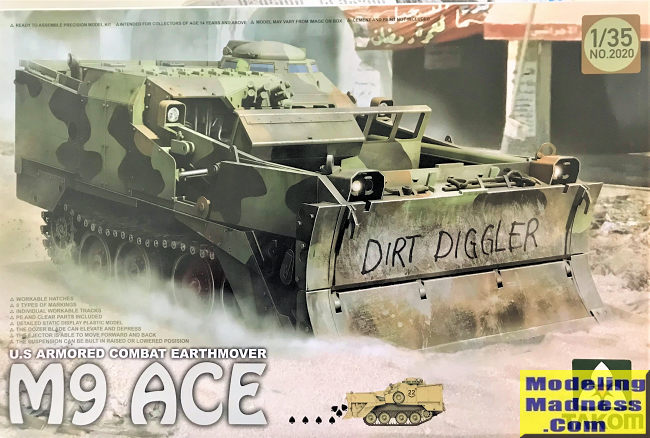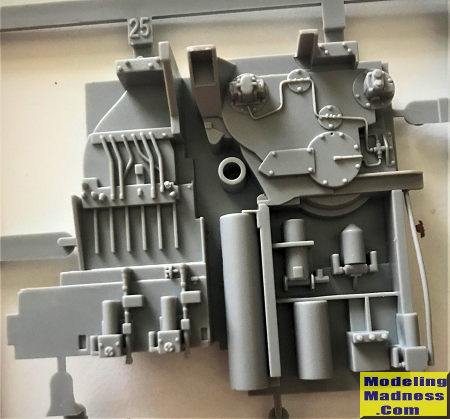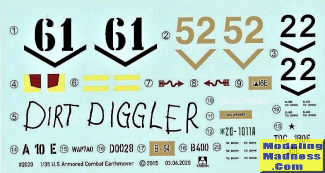
Takom 1/35 M9 Armored Combat Earthmover
| KIT #: | 2020 |
| PRICE: | $50.00 |
| DECALS: | Eight options |
| REVIEWER: | Donald Zhou |
| NOTES: |
Advantages: Extremely detailed, Esoteric subject, Easy to build. Disadvantages: Individual track links, crew hatch bottom is blocked, a lot of moving parts |

| HISTORY |
Ever since man first got angry at another man, and decided to throw a stone….or is it a wooden branch….or a stick…..or…….Anyways……..No matter what the object being thrown, or later shot out of, arrows, lead shots, bullets etc…..And even later on, far more deadlier explosives such as cannon and howitzer shells, the great Great GREAT equalizer have always been earth or other prepared obstacles such earthen berms, ditches or other defensive positions dug into the good ol’ mother earth itself. To this end, armies and fighting men have always thought of ways to either get around this or find some way to punch through defensive positions thrown up by the enemy, many of which are either ditches or earthen berms. To this end, the first “engineers” was created. They would go in with shovels or other construction implements to either dig their own defensive positions for their fellow brothers in arms or go up front and dig through the enemy’s position so their fellow comrades can advance.
As armies begin to be mechanized, so were the engineers. In World War II, many American engineers borrowed or utilized many civilian engineering equipment such as the Caterpillar D6 bulldozers and backhoes. However, these are not armored or armed. To rectify this, many of the bulldozers were wielded with ad hoc armor to at least protect its crew from enemy fire. After the war, the U.S. eventually developed the ABC or All-purpose Ballastable Crawler to replace the civilian version of the bulldozer in 1958. To replace the ABC, the UET or Universal Engineering Tractor was developed.
UET was an exciting concept. It had a bowl in front to save weight and can do the jobs of either the bulldozer or the scraper. It even had the concept of an armored cargo carrier, carrying some cargo in the bowl or even carry a squad of infantry in there in a pinch. However, interests sank, literally, when one sank during a swim demonstration.
However, the Army persisted. Like many things, it was time to dumb things down. The bowl/scrapper and dozer blade was kept. But cargo and infantry carrying ability was dropped. The swim ability was refined and the armor was lightened because there are several requirements, one of the main ones was the new engineering vehicle would be carried by the C-130 and be air droppable and swimmable. To this end, the new vehicle full weight was 21.3 tons. However, empty it was less than 19. To achieve this, the bowl was enlarged. This is because in order to bulldoze effectively, the vehicle need some heft up front to weight down the blade, allowing to dig into the earth and also to absorb the shock of the force transmitted to the arms. However, this heft ran right against the weight saving measures that was required to allow the vehicle to be airliftable by the C-130, air droppable, and the ability to swim. The bowl not only solved this problem, but also can be doubled as a scraper. When arriving at the spot, the entire dozer blade is designed to be raised well over head, exposing the bowl and the scraper blade. The vehicle then lower the front end against the ground, where it can scrape as much as 8 tons of dirt into the 8.7 cubic yard/6.7 cubic meter bowl to weight the vehicle down and to effectively bulldoze. Once done and time to get moving, a powerful hydraulic ram will clear the “apron” clean of dirt. Because of this, the vehicle also can scrape and act as a scooper/backhoe with the bowl. It can bulldoze a clearing, then raise the dozer blade, and scrape the line deeper into a trench for infantry or clear out a ditch for tanks so they can get into “hull-down” position or a larger emplacement for artillery. Or conversely, it can scrape 8 tons of dirt into the bowl, take it to a clearing, push it out, and then pack it with either the dozer blade or even itself to build up a defensive berm.
To provide a smooth ride and help with the bulldozing/scraping operations, the vehicle is equipped with hydropneumatic suspensions. Each of the eight suspension arms are attached to a hydropneumatic actuator arm. The arm can raise or lower the vehicle into three main positions. 1. A bottom lowered and front raise “lock down” position where the vehicle can be transported by either aircraft or systems like the M1070 HETS. 2. Travel position in which the vehicle is even and the dozer blade raised above ground. 3. Digging position in which the front is lowered against the ground where either the scraper or dozer blade can dig into the earth.
Behind the bowl, to the left is the single crewman station with an armored hatch. The vehicle is not equipped with any defensive armament. To the right is the Cummings V903C diesel engine developing 295HP, giving the vehicle a top speed of 30MPH and a range of 200 miles. In the center is the powerful hydraulic ram used to push the dirt clean from the bowl. Behind that is a small open air compartment where other engineering tools and personal belongings can be placed. The vehicle is armored with laminate and aluminum armor capable of defeating small arms and fragmentation fire and can swim at a top speed of 3MPH in optimal conditions through water, propelled by its tracks. To save costs, the entire running gear was borrowed from the M2 Bradley IFV.
The new vehicle, now designated the M9 Armored Combat Earthmover first entered service in 1986. A total of 449 Aces were ordered, each engineering battalions were given a total of 22 vehicles, 7 per company. The vehicle’s main missions are mobility, to help an armored thrust by breaching various obstacles such as filling ditches and clearing out berms. Anti-mobility. This is in reverse of the first mission where the vehicle is now employed to create the said ditches, berms and trenches etc. and/or any other tasks that involves either scraping or bulldozing, such as the aforementioned preparing positions for tanks or artillery.
The Aces baptism of fire came during the 1991 Gulf War. These were send as soon as other fighting vehicles were ready since they were considered a critical piece of the ground war since Sadadumb Insane’s troops build several lines of entrenchment, trenches, berms, anti-tank ditches etc right in front of what they thought were the main line of assault. Of course, we now all knew the main thrust was the famous “left hook” that took the troops completely by surprise. However, to cover the left hook, a “straight body blow” feint was also carried out. To breach the many defensive measures the Iraqis put up, the M9 was heavily utilized.
The Aces were highly successful in this regard. They were able to quickly charge in, using either its dozer blade or the scraper, were able to create several holes through the berms and then fill the ditches to allow the M1’s and M2’s to advance and were also used to clear out the now infamous “highway of death” when after a line of retreating Iraqis were detected by the J-STAR radar plane, the Air Force went in and then bombed the hell out of Highway 80, littering it with the husks of up to as much as 1,200 vehicles.
There were some hard lessons too. Namely, the Aces operators soon gained a nickname, A Yo-Yo or AUU. This stands for Alone, Unarmed and Unafraid. This literally spells out what the M9 missions entails. The M9 usually go in, with the operator sitting alone inside his small hole, without any weapons to defend himself should he be a target….And he usually is a BIG target since any enemy with two brain cells, once seeing this thing comes up, instantly will realize what it’s up to and will make an effort to kill it! And it doesn’t take much to kill an Ace since its armor is so thin it can only block small arms fire and shell splinters. Yes, it takes two big ones to do this. After the war, a review stated that the vehicle should’ve have two crew members, a driver and a commander sitting at a higher position and armed with a remotely controlled weapon station to defend itself in a pinch. Otherwise, when the thing came under heavy fire, some commanders are forced to send in two Bradley IFV’s to cover the small vehicle! This is why some also felt that some sort of strap on added armors can be given to the vehicle and can be attached if the need arises.
The other is the position of the driver’s position. Namely, since the right is taken up by the engine, the single crew man is screwed way to the left and can’t see a damn to his right. Especially at night, this problem is compounded. When the vehicle lifts up while working, the operator can’t see a thing and has no idea what is happening if any problem arises. Hence why a second crewman is so recommended at a position right above the engine at a much higher elevation so he can tell what is going on on the right side. Also, revolving CCTV cameras were highly recommended since they can cover any other blind spots that the vehicle may have when the crew is forced under his lid.
However, none of these recommendations were taken since money was tight after the Cold War was over. One thing the Army did strengthen was training as it was found out some problems were simply lack of experience in scraping and bulldozing a position. And another is that the swimming ability was dropped since the vehicle, like the early version of the Bradley, was BARELY capable of swimming and usually require the crew time to prepare it. During the Gulf War and later in Bosnia etc, it was found the thing barely if at all, did any swimming. By 2003, the same basic vehicle was used again, to great effect in the Second Gulf War. However, the same problems, namely, the operator is still A Yo-Yo, he is still very much blind on the right persists. However, after the invasion was over, add on applique armor were given to the crews to add strength against IED’s. As for operating under heavy fire, that problem eventually was finally solved by a different kind of monster, a literal monster of a different kind in the M1 ABV, or Assault Breacher Vehicle, which is now known as the M1150 Shredder.
| THE KIT |
 This vehicle had interested
me ever since I saw it in Tom Clancy’s Armored Cav book. It’s so esoteric and
strange that I thought it would be great in model form…….And that was over 20
years ago! Finally, a year ago, the new company….JESUS, it’s like every year, a
new model company pops up…Anyways……Takom announced and released this esoteric
vehicle in 1/35 scale….I always wanted to buy it. But at an initial release
price of $50-$60, it was just a bit too expensive for the small vehicle and I
had too many things going on to really purchase it. Warp to now……So a couple
days ago, I attended my local model meeting contest and got this thing as a
prize……Yes, Ima freaking happier than a tornado in a trailer park to say the
least when that happened! The model is molded in grey and contain some 532
pieces…..Although over 200 I think are the single piece tracks…Grrr…..I hate
This vehicle had interested
me ever since I saw it in Tom Clancy’s Armored Cav book. It’s so esoteric and
strange that I thought it would be great in model form…….And that was over 20
years ago! Finally, a year ago, the new company….JESUS, it’s like every year, a
new model company pops up…Anyways……Takom announced and released this esoteric
vehicle in 1/35 scale….I always wanted to buy it. But at an initial release
price of $50-$60, it was just a bit too expensive for the small vehicle and I
had too many things going on to really purchase it. Warp to now……So a couple
days ago, I attended my local model meeting contest and got this thing as a
prize……Yes, Ima freaking happier than a tornado in a trailer park to say the
least when that happened! The model is molded in grey and contain some 532
pieces…..Although over 200 I think are the single piece tracks…Grrr…..I hate the
boringness of assembly these things but they are snap on, so they work when
assembled and the outside plastic shoes are separate so that should make
painting easier. The kit also contains a working dozer blade, which can be
raised or lower and a working hydraulic ram. The suspension arms can be
positioned in the three modes that the real vehicle have.
the
boringness of assembly these things but they are snap on, so they work when
assembled and the outside plastic shoes are separate so that should make
painting easier. The kit also contains a working dozer blade, which can be
raised or lower and a working hydraulic ram. The suspension arms can be
positioned in the three modes that the real vehicle have.
Construction begin with the lower hull and running gear. Right off the bat, you need to decide which of the three mode the vehicle should be in. As stated, the Ace has three running mode of traveling, lock-down, and digging. Various holes are molded into the hull and inserting the arms into these holes will model the vehicle in any of the three modes. Carefully read the instructions and make a decision. A jig is provided to make the arms all in sync with each other.
The road wheels are assembled along with the drive sprocket. Strangely, only the outer wheels have their plastic rims separate. The inner wheels have the rims molded on. The next step will have you assemble the tracks…Might save that for later.
The next few steps will have you assemble the main apron for the bowl and the hydraulic ram cleaner. Now, the engine head and the hydraulic wall B25 just behind the ram is all molded in a single piece together. Some would prefer all these details to be separated but looking at it, the molding is superlative and does the job convincingly. This keeps the parts down and you don’t have too many small pieces to worry about.
After that is done, the engine compartment is assembled. No engine is provided but that isn’t a problem as with everything covered up, it can’t be seen.
Afterward, the rear accessories/tool open air compartment is build up. Two jerry cans are given to clutter this space up. Just a note, the door piece, B28, from what I’ve seen of videos and photos, a lot Aces had these doors removed to give the crew easy access to this space since, well, with so much hydraulics, the suspension arms, the dozer blade arms, the central ram, this thing supposed to leak hydraulics everywhere and need constant maintenance.
The crew hatch, with eight clear vision blocks, are now assembled. Strangely, and this is one of the few fault of the kit, the hatch is attached directly to the compartment roof. There is no hole here so you can’t attach a figure even though the hatch is operable. Strange decision by Takom.
The side armor are then put on next. Be careful with the hydraulic jacks that raise and lower the dozer blade. They are designed to be operable.
The last thing is the dozer blade itself. Again, careful with the folding pins. The blade can be folded in half and then of course, raised over head to allow the scraper to work. When lowered, the blade actually close off and block off the scraper blade. The model is complete after the blade is attached to its hydraulic jacks.
 Eight markings are included. Including
two in desert sand, one from the first Gulf War, the second in 2003. Two South
Korean and a Taiwanese Army are also included. Notice the Taiwanese version’s
three tone NATO style camo is a little different than the rest of the NATO
markings, which are all standard three tone NATO camo, including the box art
one, the famous “Dirt Diggler”. A photo of this vehicle, just in front of his
brethren, “The Quicker, Picker Upper------Bounty” was taken just before the
vehicle invaded Iraq so you have some weathering sources there.
Eight markings are included. Including
two in desert sand, one from the first Gulf War, the second in 2003. Two South
Korean and a Taiwanese Army are also included. Notice the Taiwanese version’s
three tone NATO style camo is a little different than the rest of the NATO
markings, which are all standard three tone NATO camo, including the box art
one, the famous “Dirt Diggler”. A photo of this vehicle, just in front of his
brethren, “The Quicker, Picker Upper------Bounty” was taken just before the
vehicle invaded Iraq so you have some weathering sources there.
| CONCLUSIONS |
Yep. Talk about an interesting vehicle. Can’t wait to get started on it. And yes, as you may surmised….I now got a line going on the “waiting to be completed project” list!
February 2018
Copyright ModelingMadness.com
If you would like your product reviewed fairly and fairly quickly, please contact the editor or see other details in the Note to Contributors.
Back to the Main Page Back to the Review Index Page Back to the Previews Index Page